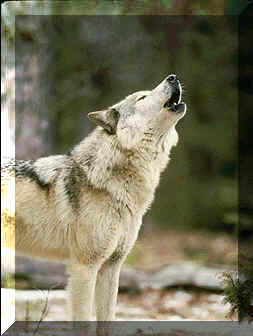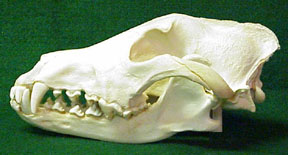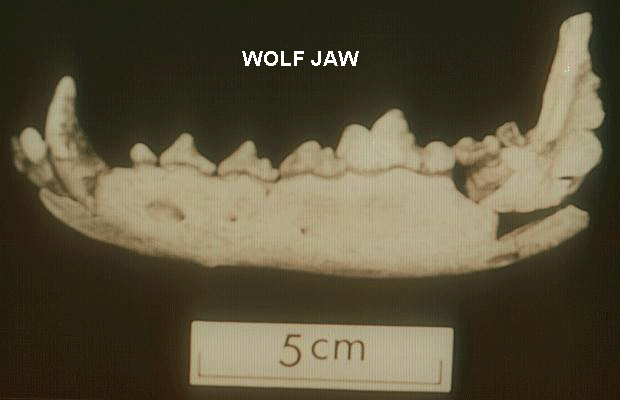|

Size and Weight:
Wolves are the largest members of the dog family, Canidae. They can be from 24 inches (60 cm) to 36 inches (90 cm) tall at the shoulders, and 60 inches (150 cm) to 72 inches (180 cm) long from head to tail tip. They weigh from 60 lb (27 kg) to 120 lb (60 kg) (Averages are from the smallest for females to the largest for males). Wolves in the northern most parts of their range are larger than wolves farther south. Arctic wolves can be up to 175 lb. as compared to the Mexican wolves which are usually no more than 75 lb. Arabian wolves can be as small as 25 lb. Wolves and other wild canids have a scent gland located at the base of the underside of the tail about 1/2 in. from the anal opening. 
Coat coloration and design:
Wolves have a double layer coat; the top layer is comprised of thick, oily guard hair that repels water, and the second layer consists of soft undercoat fur, which keeps them warm. Almost no heat is lost through a wolf's coat; not even snow will melt on a wolf's fur. The wolf uses its bushy tail to cover its nose in the winter, so that its warm breath is reflected back into its face to keep its nose warm. Wolves shed their undercoat during the summer months to keep cool. Wolves can be any color, from pure white to jet black. The many colors that can make up their coat are: white, black, many shades of grey, cinnamon, cream, brown, silver and gold. Usually, wolves are one or more of these colors combined. The coloration of wolves' coat is on their guard hairs. Their hairs are not a solid color, but each individual hair is banded with many colors, ranging from pure white to black. This banding is called "agouti", so named after the South American rodent whose coat sports this pattern. This banding pattern is caused by a chemical known as eumelanin, which during the growth of the hair is turned off and on, creating this banding pattern. The banding is less or more extensive over different areas of the wolf's body. In areas where the eumelanin was more active there are more bands of color, and these areas are where the wolf is darkest. The majority of wolves have a darker greyish color on the dorsal areas of their body: around the top of their head and ears, in circles around the eyes (also known as a "mask"), on the front of the top of their legs, along their backs and top of the tail. Wolves are lighter on the ventral areas of their body: the lower jaw, underside of their upper jaw, the cheeks, directly around the eyes, on the insides of the ears, on the underside of the neck and chest, the back of the legs, the entire foot, the insides of the legs, and the underside of the tail. There is also a lighter band of color that extends from the elbow to the shoulder. These were areas where eumelanin was surpressed and little banding if any is present. Many wolves have a cinnamon color around their ears and along their muzzle. 
Color changes over time:
Most wolves, especially the black wolves, have a gene that codes for their color to fade. A wolf that is black one year soon develops a little white around its face and muzzle the next year, and that white moves further along its body each year. There have been cases where all-black wolves have actually turned pure white by the time they are eight to nine years old! Wolves also change color between seasons. They are their truest boldest colors in the wintertime. In the summer, when they shed, their coat becomes more greyer; so a white wolf becomes a little darker, and a black wolf becomes a little lighter. It is not really noticeable that much, they still look pretty much the same all the time, just a few shades different. Wolves that do not have the gene for coat fading still do change color as they mature to adulthood. Most arctic wolf cubs are a medium brown or beige, and as they mature their coat bleaches to a clear white. Timber wolf cubs are also born a brownish color with darker timber markings, but they usually loose their brownish coloring and gain more of a grey and white contrast to their coat.  Fur length patterns:
In addition to fur color patterns, wolves also have fur length patterns. The most noticeable one is the three "capes" that layer the wolf's coat along it's back. These capes, one from the back of the neck, one on the mid-back, and one that runs to the base of the tail, serve to help disperse water as it runs along the wolf's back.
The length of the hairs vary on the wolf's body as well. Wolves in cooler climates have longer and thicker hair covering their body, whereas wolves in the tropics or deserts have about the same length of hair all over, with slightly longer hair on the mane. On all wolves, the hair on the mane is longest, being around 1 1/2 to 4 inches long, and thickest, followed by the hair on the back and tail. The hair on the muzzle is shortest of all, being maybe 1/16th of an inch long. The hair on the body graduates slowly from 4 inches to 1/16th of an inch. 
Wolf Body and Skull Structure:
Wolves are shaped for running. Most of the canids hunt by stalking their prey, then running them down with blinding speed. Such adaptations that help them do this are their deep, narrow chest and their long, narrow legs that hold tight together, almost pressed into their chest. They leave a single line of tracks when they walk. In addition, wolves can run up to 40 mph for short distances, and can travel 40-70 miles in one day. Wolves are digitigrade, which means that they walk on their toes rather than their entire foot, which makes their legs longer and makes them more agile. They also have non-retractable claws, which can clearly be seen in their tracks. Wolves' tracks are generally 3.5"-4" wide and 4.5"-5" long.
Wolves have a long, narrow skull with a prominent saggital crest (the bone on the base of their skull). The saggital crest is where the powerful jaw muscles attach to in order to provide enough leverage for their powerful downward bite. The eye sockets are large, and near the front of the skull, like all carnvores.
Wolves' eyes can be one of three colors: yellow, green, or rust. Their eyes are blue and turn one of these colors when they are adults. Wolves with light coat color typically have dark eye coloration, while those with dark coat color have light eye coloration. 
Wolf teeth:
Wolves have 42 teeth in a long, narrow mouth. Their four canine, or eye teeth, can be 2 inches long, enabling them to pierce the tough hide of their prey. They have four one inch (2.5 cm) long canines, two on the top, two on the bottom. They also possess four carnassials, the hallmark of the order Carnivora. The carnassials are molar-like teeth towards the back of the mouth that are used for shearing meat. Their incisors, the teeth in the very front of their mouth, are very small and used for grasping objects from the front of the mouth. They have 12 total, six on the top, six on the bottom.
|

